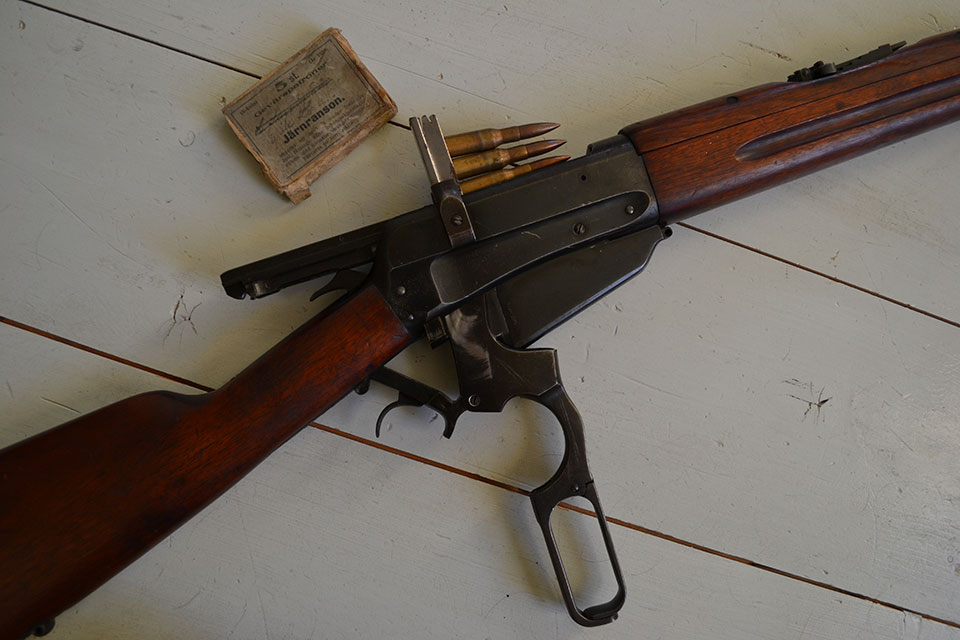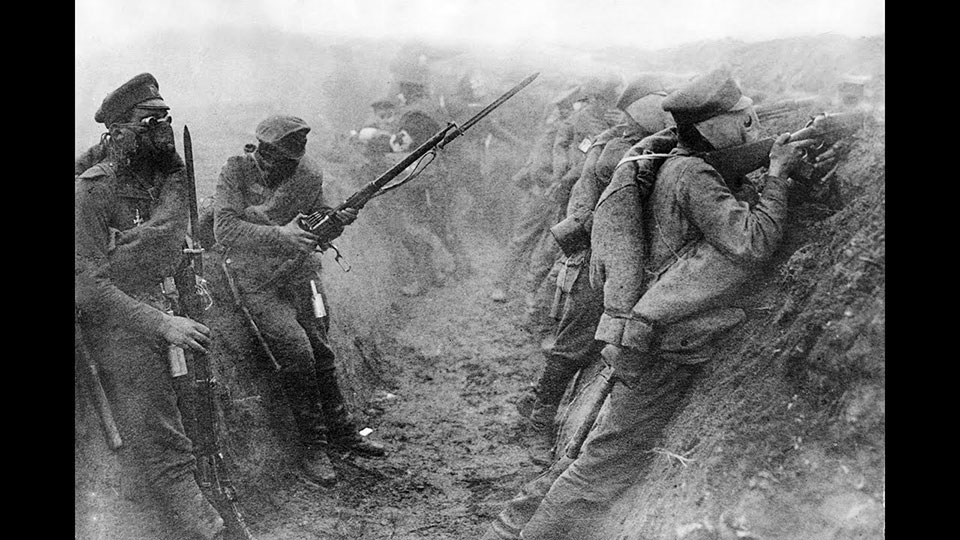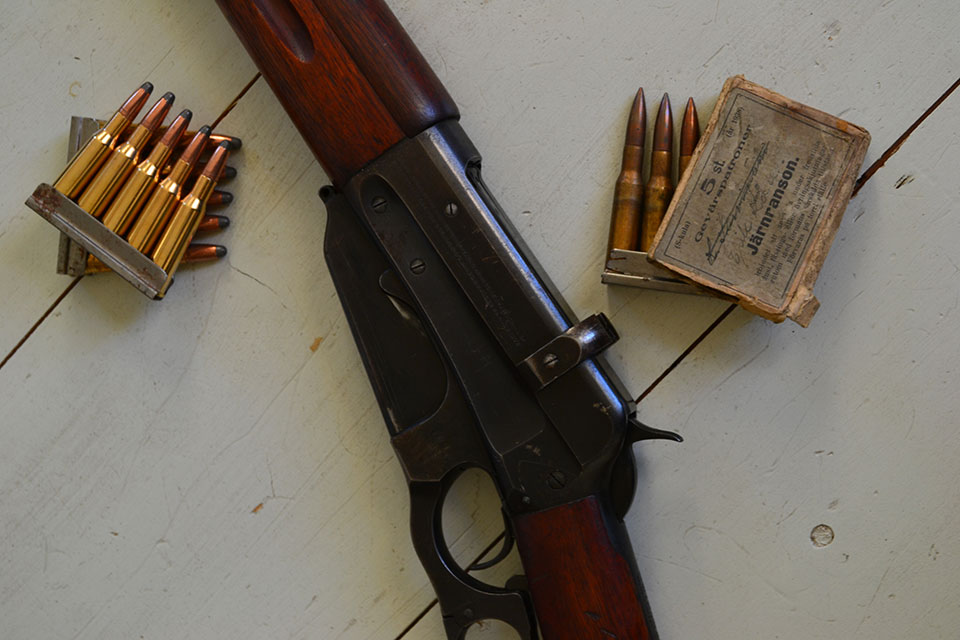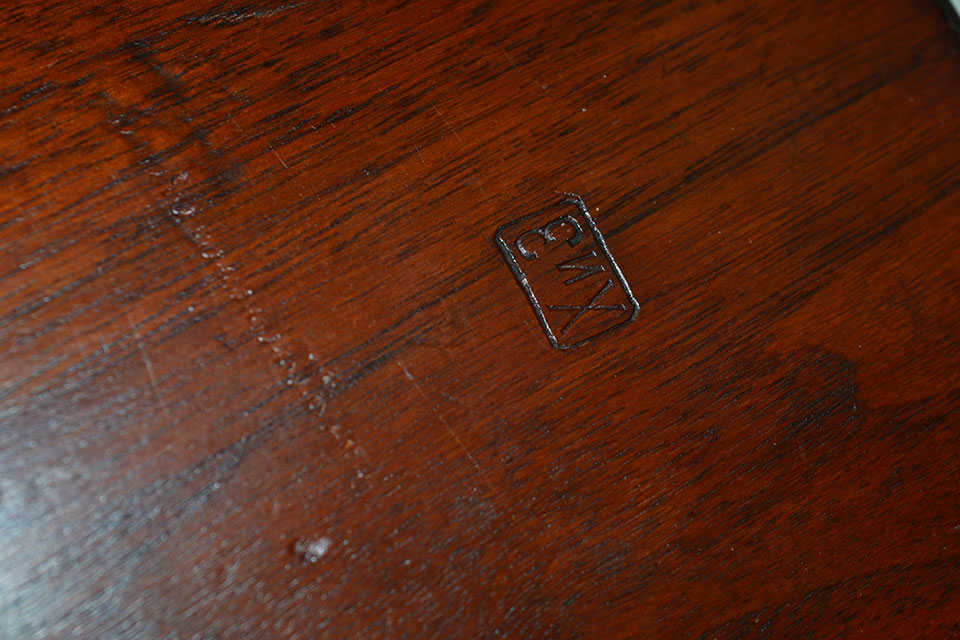John Moses Brownings last leveraction gun made for Winchester was the model 1895, shortly after he would find himself in a financial dispute with them regarding royalty payments and by the whim of fate end up at the doors of Fabrique Nationale in Herstal, Belgium where he would to the joy of later gun afficionados continue to develop other legendary firearms. One can find it a bit ironic that FN now own the rights to not only Browning but also Winchester.
The leveraction rifle had by the second half of the 19th century become somewhat of a trademark for Winchester much thanks to John Moses Browning. Guns as those later christened “the gun that won the West” and “Yellow boy” have made a great impression in the history of guns but there are also examples of leveractions less successful.
Winchester wanted J.M Browning to develop a leveraction shotgun which he hesitantly did, he was convinced a pumpaction mechanism would be a superior choice for a shotgun. The leveractionshotgun didn’t quite become the great success Winchester had hoped for but for every man woman and child having the slightest of interest in 90’s actionmovies, the shotgun would about 100 years after its launch be one of the most famous firearms when Arnold Schwartzenegger singlehandedly reloaded a Win 1887 in the 1992 blockbuster “Terminator 2”. Browning was later proven right with the pumpmechanism, model 1890, 1893 not to mention 1897 became big hits and laid the foundation for the standards of the future.

The powerful smokeless gunpowders of the new era entered the gun industry in the late 1800’s, which set new demands on the construction of the rifle to handle the bigger pressureloads.
Model 95 was the first leveraction with a boxmagazine instead of the for Winchester typical tubemagazines. This allowed the new powerful cartridges to be equipped with spitz type bullets when there no longer was a risk to ignite other cartridges in the tubemagazine by recoil.
Earlier leveraction models were loaded through the charging port on the side, m95 is loaded from the ejection port straight down into the magazine.
The mechanism is locked at the rear by a “rising lug” to withstand high pressures without a risk of the lock giving in.
When recharging the lever is pushed down, the triggerplate Is pushed down at the same time which is good for safetyreasons but a disadvantage is the longer momentum which makes it slower to recharge as oppose to f.ex a Winchester 1892.
For hunting this is very rarely an issue but at the battlefield where life or death could be determined by a slightly slower recharge, the difference is of the essence.

Big Medicine
About 10 000 m95’s were made for the US military for testing and amongst others the future US president Theodore Roosevelt chose the m95 for his voluntary cavalry “the rough riders” during the Spanish-American war. The leveraction chambered in 30-40Krag was found suitable to be used on horse back in the various terrains of Cuba.
Model 1895 was also chambered in .303british, 30-03, 7,62x54r, 30-06springfield and immortalized in the potent .405WCF. This was the most powerful rimmed cartridge of its time and it remains to this day a highly capable huntingcartridge, on pair with .450Marlin.
The gunmodel later saw action in Mexico at the hands of the soldiers of Pancho Villa as well as in the Philippines and the Spanish civilwar, various law enforcements also saw potential in the gun, Texas Rangers and Arizona Rangers to probably be the most known.
Previously mentioned Theodore “Teddy” Roosevelt was also a dedicated hunter and brought amongst other guns two Winchester 1895 on a famous safari in 1909. One chambered in 30-06 and the other chambered in .405WCF which was chosen for lionhunting. This gun has been presented in Roosevelts book “African game trails” as the medicine gun for lions when Teddy chose his leveraction gun instead of the doublerifle suggested by the huntingguide to kill a majestic lioness.

Russian Contract
By 1914 the Russian armed forces were very badly affected by the fighting scenes on the eastern front. There were no shortage of men in the vast Russian empire and the army was in fact the largest in Europe at the time but they simply had not enough equipment.
Mosin Nagants were being manufactured at raging speed but the armouries of Russia could not keep up with the demand. America was luckily enough still allies with Russia before the entrance of the Bolsjeviks and both Remington and Westinghouse made Mosin Nagants to send across the globe to the battlefields of the first world war. Although this helped it wasn’t enough to still the need of firearms and to save time Russia ordered model 1895 from Winchester. The idea was to get these produced fast as the equipment and machines were already there, but as Russia had specific needs the fast deliverytime remained a theory.
The Russian contract model1895 was of course being chambered in the Russian Nationalcalibre 7,62x54r and it had to be compatible with the Mosin Nagant stripper clips. A specially made bayonet and the sights modified to the Russian unit of measure “arsin” was some of the demands.
The delivery didn’t go exactly as planned, rumour has it that the Russians discarded a huge number of guns due to cosmetic faults which shouldn’t have been any obstacle on the battlefield but despite that about 300 000 Winchester model 1895’s found its way to the russian Empire out of a total of 700 000 manufactured model 1895’s.
A big portion of these were sent to the Baltics and to the other side of the Gulf of Finland which was then the Grand Duchy of Finland, an autonomous part of the Russian Empire. As the Russian Revolution tore the Empire to pieces, Finland declared independent. As the Russian soldiers were exiled, stockpiles of Russian weapons were left behind. Mosin Nagants as well as Winchester 1985.
In the following Finnish civil war Winchesters played a big part mainly in the hands of the Bolsjevik friendly “Reds”.
The white side of the civil war however turned out victorious and the Winchester rifles were being “put on the shelves”. The Finnish Army called these 7,62kiv/95 Winchester and the ones being put in storage by the army were marked as everything else in the Finnish Army with the stamp “SA”. The Model 95 made a small appearance in the Finnish Winterwar against Russia in 1939 and in the following Continuation war it was mainly issued to reservtroups as the lever by now had been found out of fashion and difficult to recharge while lying down in modern warfare.
After the wars huge numbers of model 95’s were discontinued by the Finnish Military either by sales or by scrapping them! It had been illegal since 1933 to use military calibres for hunting and big game couldn’t be hunted with anything smaller than 8mm. the result was that huge numbers of old militaryrifles including Winchesters, Mosin Nagants and even SVT-40’s were being sporterized. They cut stocks and bored barrels to 8,2x53r or 9,3x53r. These sporterized rifles have been quite easy to find in Finland but guncontrols and loss of value makes more and more of these facing death by scrapping.

About 12 years ago I found my first 1895. I had my mind set on buying a Marlin Guidegun in 45/70 but when trying these side by side there were no turning back for me. It was severely sporterized but had its original barrel in 7,62x54r. The stock had surprisingly beautiful wood and the handling was just so much better than the Marlin which felt like swinging a treestump in comparison.
I convinced myself that this was the rifle for me, I could shoot as much as I wanted since surplus ammo was found cheap in every huntingstore. I had a John Moses Browning designed gun and plans started to form, of course I was going to build my own “medicine gun”. Caliber no other than .405WCF would do, if it was the right thing for Teddy Roosevelt lioness, it would most likely make do for our Finnish roedeers and racoondogs… as time went by I started to appreciate the simple caliber 7,62x54r. it was far more suitable for my kind of hunting, big bores would have to wait until I make it on my own African Safari.
Original military weapons started to be more interesting and my youthful willingness to sporterize a m95 faded in favour of restoring it to its former glory. I now realized what I really needed was an original model95 and keep my old one as a trainer.
This was a mission that wasn’t as easy in practice as in theory. Original model 1895’s were simply not available, the few I did find in Finland were either in really bad shape or came with a pricetag equivalent to a smaller finnish loghouse or both!
Years went by and my stock of cheap surplus ammunition decreased and as other weapons gained my interest the old Winchester found its way deeper and deeper in the back of the gunsafe. I finally decided to sell my trusty old friend to someone that would appreciate it for what it was, a charming leveraction gun with a heritage outpassed by few. After all, a gun not used is not a joy for anyone.
As weird as it sounds, I had just only sold my rifle together with my last remaining ammo when a workbuddy contacted me. His relative was getting rid of some old guns and because he knew my interests he asked if anything was interesting to me.
the old Winchester found its way deeper and deeper in the back of the gunsafe
Sometimes when Mohammed can’t get to the mountain, appearently the mountain can appear on Muhammeds doorstep. In the middle of old sporterized Mosin Nagants, Brno .22lr rifles and Belgian hammershotguns a Winchester model 1895 Russian contract in good condition appeared. I looked at every picture of a Russian contract m95 I could find and indeed the Winchester I was offered certainly looked original.
It was common in Finland in the 60’s to reblue and “renovate” old guns to what they then believed would help retain the value of the gun, I certainly hope that man has been wiser with the years and this is a phenomenon of the past! Wether this rifle had been a victim of a former renovation the owner did not know. I told myself that every house needs a model 95 and I bought the rifle then and there over the phone.
When the rifle arrived I felt like a child on Christmas day, my instinct had served me right, the rifle was original and in very good shape! Even the original borebrush was in the stock compartment.
This example of a gun which I can proudly call my own doesn’t have an “SA” stamp which means it has never been in the possession of the Finnish Army. The story according to the sellers family seems plausible, sometime around 1916-17 the gun arrived at the Russian garrison in Vaasa on the Westcoast of Finland. During the fight for independence (Vaasa actually acted as the nations capital at the time) someone “liberated” the gun, took it home and placed it on the wall. It had basically sat on the same wall for about 100 years at the same family.
I cleaned the gun and put a couple of drops of gunstock oil on the dry wood. Loaded 2 Mosin clips and nervously headed to the range. The smile broaden on my face as the shots took where I aimed on 75m and the leveraction run smooth and flawless. A 10 year search for the perfect Winchester 1895 Russian Contract had ended.
The smile broadened on my face as the shots struck where I aimed
I have come to terms with realizing that finding an original Russian contract in this condition is a once in a lifetime occurrence. More and more end up as scrap as the value is seen as low when relatives have to sort out the estate of the older generation.
At least my example will not face this fate, it is the foundation of a hopefully big future collection. I want my children to have the opportunity to enjoy a piece of antique American engineering whenever they want to. Doesn’t matter if their minds associate to cowboys and Indians, Russian Kosacks or charging lions this gun will keep their fantasies and dreams alive.
Older weapons doesn’t just appeal to me because of the superior quality and marksmanship, as important are their role in shaping the history of the world as we see it today. To finally become the owner of a weapon that looks exactly as it did when it left the factory in New Haven over 100 years ago with the intention to defend mother Russia but as an act of faith instead played its part in the fight for Independence for Finland and even more in my near region gives me a sense of pride and satisfaction that is difficult to put into words.
NOTES
Arsin
At least since the 16th century, Arsin has been used as a unit of measure in Russia. It was replaced in 1925 by the communists in favour of the metric system.
It derives from practical measurements such as the width of a hand, 4 handwidths = one arsin. Peter the Great standardized the unit in the 19th century and made it relative to the English system. One arsin became equal to 28 English inches or 71,12cm.
7,62x54r
The Russian Empire used out of fashion Berdan rifles up until the end of the 1800’s. It was decided to adapt a more modern cartridge to the modern new rifle. The Mosin Nagant saw first light in 1891 chambered in 7,62x54r or the Three Line Cartridge as it was first called. This name was also due to the arsin measurements, 1 line=2,54mm. 7,62x54r has become one of the oldest cartridges still in military use. Russia still chambers their Dragunovrifles in the caliber and the Finnish army use their version of the caliber 7,62x53r to some extent.
Kristian Johansson
Published by Vintage Guns Ltd on (modified )




